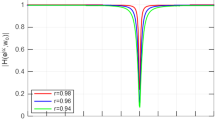Abstract
The development of a block-state structure with minimum round-off noise subject to ℓ2-norm dynamic range constraint is outlined. The pertinent equations for scaling and for round-off noise analysis of block-state structures implemented using fixed-point arithmetic are first derived. Next, a lower bound and the global minimum of the output noise due to the round-off of the block-state-variables are derived. A method of deriving the minimum round-off noise block state-structure is outlined. A numerical example is included. With regard to computational complexity and overall noise performance, the block-state realization of recursive digital filters is shown to be superior.
Similar content being viewed by others
References
S. K. Mitra and R. Gnanasekaran, “Block Implementation of Recursive Digital Filters — ew Structures and Properties,”IEEE Trans. Circuits and Systems,Vol. CAS-25, No. 4, April 1978.
B. Gold and K. L. Jordan, Jr., “A Note on Digital Filter Synthesis,”Proc. IEEE (Lett.), Vol. 56, pp. 1717–1718, October 1968.
R. Gnanasekaran and S. K. Mitra, “A Note on Block Implementation of IIR Digital Filters,”Proc. IEEE (Lett.), Vol. 65, pp. 1063–1064, July 1977.
C. S. Burrus, “Block Implementation of Digital Filters,”IEEE Trans. Circuit Theory, Vol. CT-18, pp. 697–701, November 1971.
C. S. Burrus, “Block Realization of Digital Filters,”IEEE Trans. Audio Electroacoust., Vol. AU-20, pp. 230–235, October 1972.
H. B. Voelcker and E. E. Hartquist, “Digital Filtering via Block Recursion,”IEEE Trans. Audio Electroacoust. (Special Issue on Digital Filtering), Vol. AU-18, pp. 169–176, June 1970.
R. Read and J. Meek, “Digital Filters with Poles via the FFT,”IEEE Trans. Audio Electroacoust. (Corresp.), Vol. AU-19, pp. 322–323, December 1971.
J. W. Meek and A. S. Veletsos, “Fast Convolution for Recursive Digital Filters,”IEEE Trans. Audio Electroacoust. (Corresp.), Vol. AU-20, pp. 93–94, March 1972.
S. Y. Hwang, “Minimum Uncorrelated Unit Noise in State-Space Digital Filtering,”IEEE Trans. Acoustics, Speech, and Signal Processing, Vol. ASSP-25, No. 4, August 1977.
C. T. Mullis and R. A. Roberts, “Synthesis of Minimum Round-off Noise Fixed-Point Digital Filters,”IEEE Trans. Circuits & Systems, Vol. CAS-23, pp. 551–562, September 1976.
S. Shinnaka, “Block Implementation of Digital Filters,” Ph.D. Dissertation, Department of Electrical Engineering, University of California, Irvine, 1979.
C. W. Barnes and S. Shinnaka, “Finite Word Effects in Block-State Realization of Fixed-Point Digital Filters,”IEEE Trans. Circuits & Systems, Vol. CAS-27, No. 5, pp. 345–349, May 1980.
P. Ananthakrishnan and S.K. Mitra, “A General Theory of Block-State Digital Filters,”Proc. IEEE International Symposium on Circuits and Systems, Rome, Italy, May 1982, to be published.
Author information
Authors and Affiliations
Rights and permissions
About this article
Cite this article
Ananthakrishnan, P., Mitra, S.K. Minimum round-off noise realization of block-state recursive digital filters. Circuits Systems and Signal Process 1, 217–231 (1982). https://doi.org/10.1007/BF01600053
Received:
Issue Date:
DOI: https://doi.org/10.1007/BF01600053




